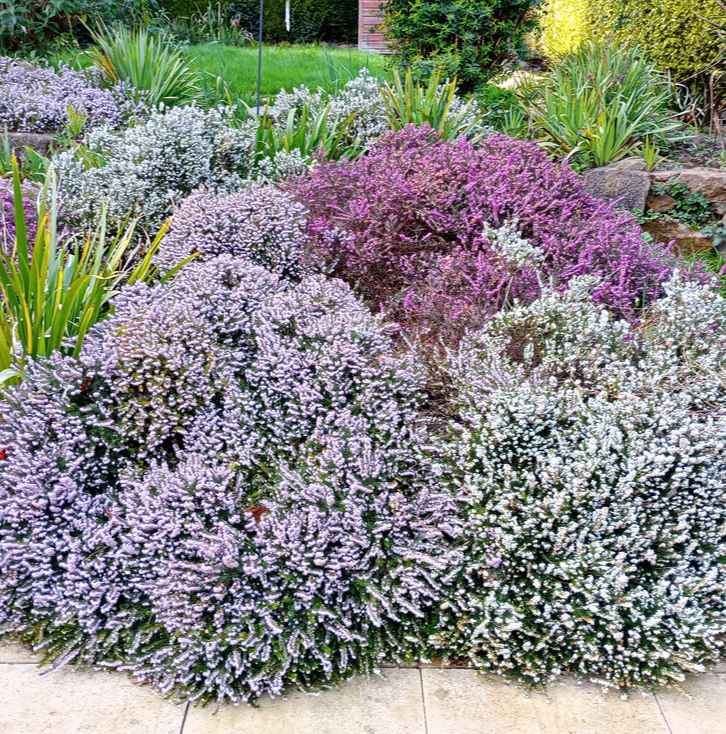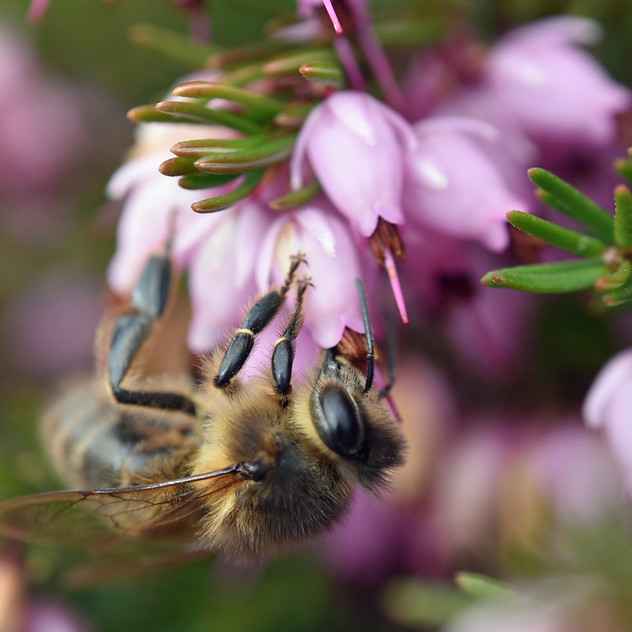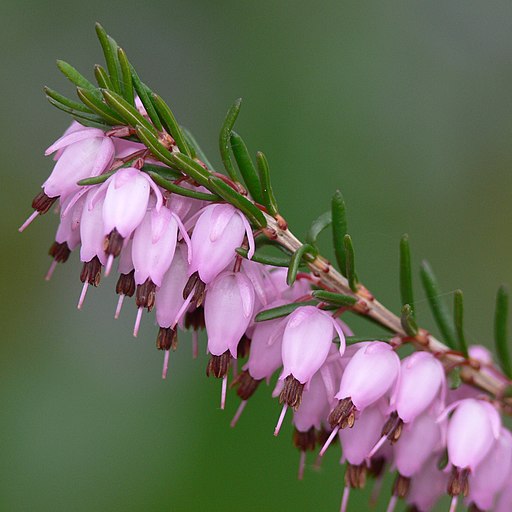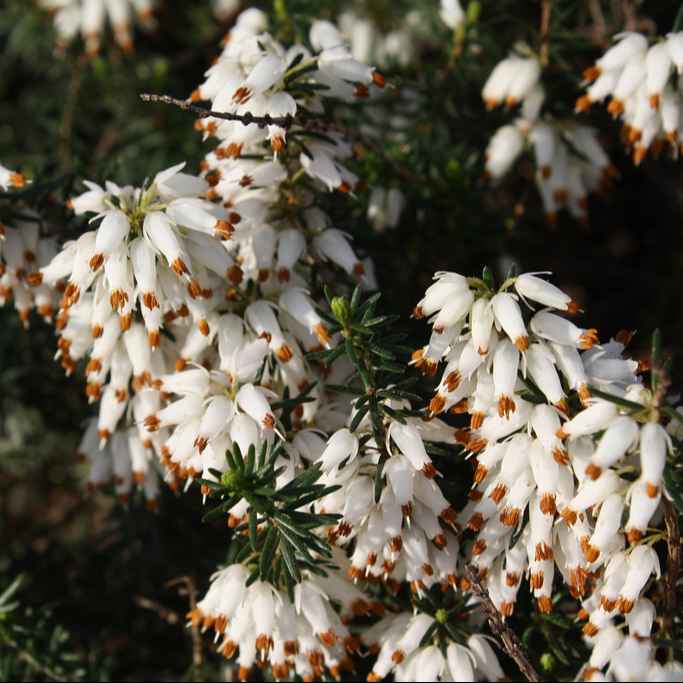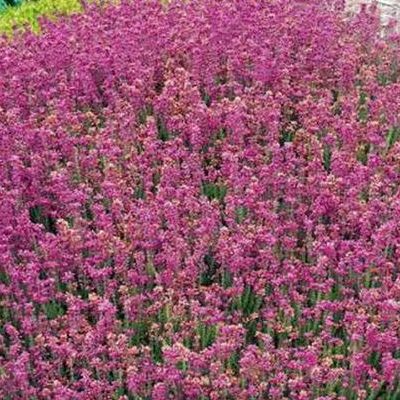Erica Carnea - Winter Flowering Heather
Erica Carnea - Winter Flowering Heather
Winter flowering heather - Alpine Heath
Available for dispatch from May
Couldn't load pickup availability
Sustainably Grown Organic Erica Carnea
🌿 I grow a few different colours of organic Erica Carnea - Lilac, Pink and White which flower in winter and spring. The tiny bell-shaped or tubular flowers cover these compact evergreen heathers, creating a colourful carpet when little else is in bloom. This hardy perennial is easy to grow, drought-tolerant, and adaptable, and will brighten up any garden with its cheerful display.
🌸 Flowers: Erica Carnea has tiny bell-shaped or tubular flowers that are arranged in clusters or spikes at the tips of the stems. The flowers are usually fragrant, especially in the evening, and attract bees and butterflies with their nectar and pollen. The flowering period lasts from December to February, making Erica Heather one of the few plants that can brighten up the winter garden.
🌿 Habit: This Heather is a compact, bushy, evergreen shrub that grows up to 35cm in height and spread. It has fine, needle-like foliage that is densely packed on the stems, creating a soft and feathery texture. Erica Carnea has a shallow root system that does not compete with other plants for nutrients or water, making it ideal for growing in containers or rockeries.
🏡 Landscaping: Erica is a versatile and adaptable plant that can be used in various ways to enhance the beauty and diversity of your garden. It is ideal for rockeries, borders, containers, or ground cover, as it can tolerate dry, well-drained, acidic or neutral soils (and will tolerate alkaline) and full sun or light shade. It can also be massed together for a stunning effect or mixed with other plants for contrast. Erica can create a colourful carpet when little else is in bloom, or complement other winter-flowering plants, such as cyclamen, crocus, or witch hazel. It can also be used to create a naturalistic or cottage garden look, or to soften the edges of stone features, such as walls, steps, or statues.
🌸 Maintenance: Low-maintenance, requiring only occasional pruning to keep shape and remove dead or damaged stems. Prefers well-drained, acidic soil and full sun or light shade. Mulch with leafmould if possible to maintain acidity and soil structure.
🍂 Seasonal Interest: Provides year-round interest with evergreen foliage and winter-spring flowers. Attracts bees and butterflies with its nectar-rich blooms.
🦋 Supporting pollinators: Heather is a great plant for supporting pollinators, especially bees and butterflies, as it provides them with a valuable source of nectar and pollen during the colder months when other flowers are scarce.
🏡 Garden Uses
Ground cover: Erica Heather can fill in gaps between other plants, suppress weeds, and prevent soil erosion. It can also create a striking contrast with plants that have larger leaves or flowers, such as ferns, hellebores, or snowdrops.
Border plant: Add colour and texture to the edges of your garden beds, paths, or walls. It can also be used to create a naturalistic or cottage garden look, or to complement other winter-flowering plants, such as cyclamen, crocus, or witch hazel.
Pots & Containers:, Erica Heather can brighten up your patio, balcony, or doorstep with its cheerful colours. It can be grown in pots, baskets, or window boxes, either on its own or mixed with other plants that have similar growing conditions, such as dwarf conifers, sedums, or ivies.
Rockery plant: Erica Heather can thrive in the dry, well-drained conditions of a rock garden, adding colour and interest to the crevices and slopes. It can also be used to create a miniature alpine garden, or to soften the edges of stone features, such as walls, steps, or statues.
🌱 How to Care For Erica Heather
Erica Heather is a low-maintenance plant that does not require much attention once established, but there are some simple steps you can take to ensure it grows healthy and happy.
- Watering: Erica Heather is drought-tolerant and does not like wet or soggy soil. Water only when the top few centimetres of soil feel dry to the touch, and avoid overwatering or waterlogging. Reduce watering in winter, especially if the plant is in a container.
- Feeding: Heather does not need much fertiliser, as it can grow well in poor or acidic soil. However, you can apply a balanced, organic fertiliser once a year in spring. Do not apply lime, although it is a alkaline soil tolerant heather.
- Pruning: Pruning is not required, as it naturally forms a neat and compact shape. You can trim off any dead or damaged stems, or lightly shear the plant after flowering to encourage new growth and prevent it from becoming leggy or woody. Do not cut into the old, woody stems, as they may not regrow.
🚫 Is Erica Carnea Invasive?
No, Erica Carnea is not invasive, as it does not spread aggressively
🌿 Eco-Friendly Packaging and Delivery
I grow all plants in pots made of wood-fibre that can decompose or in wooden troughs and then wrapped in hessian, reducing waste and avoiding plastic.
I deliver the plants using Royal Mail, which has the smallest carbon footprint for each parcel in the UK. The delivery has very low carbon emissions, but I also support environmental projects to offset them even more. This way, I make each delivery greener and more responsible for you.
Plant care guide
Plant care guide
How do you plant shrubs & woody plants?
Dig a hole slightly larger than the rootball size, but no deeper. If it is a plant that likes to stay on the drier side (such as lavender), make the hole slightly shallower than the root ball so the surface of the rootball sits proud of the ground and use organic matter around the plant to stop water pooling on the base of the plant.
Water the hole and if the plant rootball doesn't seem moist pre-soak the hessian contained rootball until it is saturated (no more bubbles rise to the surface).
There is normally no need to add compost to the hole if you have an established garden with healthy plants already growing. If you have a newbuild property or poor growth to existing plans chances are that your whole flowerbed needs improving with organic matter.
Place the rootball in the hole. You can remove the hessian sacking it came in, or just remove the staple/twine and open the top once it's in the ground so the plant is free. The roots will easily grow through and the hessian will decompose. Back fill the surrounding area with the dug soil. Do not firm the soil down hard! Roots need air and water and hard compacted soil prevents them from getting both.
Once planted water the plant in well and then water again whenever the soil starts to dry out under the surface, being careful not to overwater.
Mulching with something like woodchips around the plant after watering will help the soil to retain the moisture in hot weather. The perennial's foliage will die off in the winter and the plant will regrow through the mulch in the spring!
When to plant woody plants in the UK?
Our plants can be planted out in the garden or in pots from spring, through the summer, to autumn. During dry weather and especially during the summer much closer attention needs to be given to watering in the first year. Our plants supplied in 6 cm pots they will benefit from being grown on in a protected area before planting out.
If planting in hot weather, cut the foliage and flowers back if they are large. Your new plant will not be taking up much water until established so may struggle if the leaves lose more water than the roots can absorb. For the strongest result do not allow to flower or at least to set seed in the first year.
Where to plant woody plants?
Check the plant info at the bottom of the page for the best place to position your new plant. If it prefers sun and you site it in a north facing flowerbed next to a wall don't expect it to thrive or flower.
Pay attention to the soil. if it is heavy clay, incorporate organic matter such as compost to the soil before planting your shrub, preferably to the whole flowerbed. This will improve the soil by buffering it's water and nutrient holding ability. It is preferable to not just plonk compost in the bottom of the hole as it will not improve the overall condition of the soil surrounding your new plant. Do not add a layer of gravel or grit to the bottom of the hole as this will merely cause the perched water table to be higher. It will not improve drainage.
How do you care for woody plants?
Cut back untidy or dead stems in the spring (you can leave the clippings on the flower bed to allow the nutrients to recycle into the soil).
Should woody plants be fertilised?
The vast majority of garden soils contain plenty of nutrients, but if your garden is in a newly built development there is a good chance a thin layer of topsoil has been added on top of infertile subsoil. if that is the case, compost, soil improver or well rotted manure can be spread on the flower bed and dug in, or alternatively for those short of time or energy, organic fertiliser such as our own special organic mix of bone meal, hoof and horn and vinaase that is an organic, sustainable alternative to the John Innes formula, can be sprinkled around the plant with some compost added to the planting hole. Shrubs that are vigorous may benefit from supplementary feeding too as they may deplete the soils nutrients.
Delivery £5 flat rate or FREE over £80 spend.
Delivery £5 flat rate or FREE over £80 spend.
I charge a flat rate of £5 for postage and packaging to all of Britain, including the Highlands and the Isle of Man, with free delivery for orders over £80. We are unable to send plants to Northern Ireland.
I use Royal Mail for our deliveries as they have the lowest carbon footprint per parcel delivered in the UK and actually tend to look after parcels rather than just chucking them over the nearest fence! This ensures that your plants will have the best care possible.
Please have a Safe Place set up if possible so your plants are not returned to the sorting office if no one is home to accept the delivery.
I try to dispatch plants twice a week and you will receive updates by text or email. In cases of extreme weather or if Royal Mail has a hiccup the delivery may be delayed but we'll keep you in the loop.
I'm unable to deliver to the Channel Islands or Northern Ireland.
The LAWNMOWER Guarantee
The LAWNMOWER Guarantee
Healthy plants & happy customers
Your plant will only be dispatched if I'm happy it is healthy. The nature of growing the plants in large troughs means that the root system will be trimmed before they are balled in hessian, and therefore, depending on the time of year, the top growth may also be trimmed to make sure the roots are able to supply the water and nutrients your new plant requires.
Pruning encourages new growth and this applies to roots as well so a pruned plant actually results in a stronger plant.
The LAWNMOWER guarantee.
If you're not happy with your plants for any reason, even if you've run them over with your lawnmower, just pop them in a box (the plants, not the mower!) and post them back to us within 1 year for a replacement or refund.
This does not affect your statutory rights.
For full details check out the Refunds and Returns Policy.
Sustainability
Sustainability
Eco-friendly business
Fed up with plants grown in plastic pots which are doused in herbicides and sprayed with synthetic chemicals by big nurseries who merrily burn through finite resources, fly plants in from abroad on jet planes, irresponsibly use peat and coir, kill any insect nearby with non-selective pesticides and generally only think of the bottom line?
So are we!
How we grow plants sustainably
Our plants are started in coldframes or inside our house, grown-on woodfibre pots or in reclaimed wooden troughs which are then carefully harvested and balled and burlapped (hessian wrap securing the rootball), before packing plastic free in a eco cardboard box from a certified B-corp carbon neutral supplier. Some plants are grown in 8cm woodfibre pots.
Sustainable and organic compost & fertiliser
Our Soil Association certified organic compost is bought in bulk without plastic bags from Dalefoot Compost, and consists of sheep wool, bracken and comfrey. This naturally feeds the plants for 12 months. If supplemental feeding is required we only use our own special blend of organic fertilisers (bone meal, hoof & horn and vinaase) which have been processed with solar energy.
Carbon Neutral business
The small amount of electricity we use is from renewable sources and we irrigate our plants with stored water we have harvested. Plus, we are using our house and land for more than one purpose, preventing further land use and utilising the sunk carbon cost of the building rather than creating more.
We have partnered with Carbon Neutral Britain to offset our emissions, and recognise that we are not in control of all parts of the supply chain so have fully offset scopes 1, 2 and 3 to take that in to account - so that's all emissions connected to our business, from the farts coming out of the back of the sheep, to the carbon dioxide from the delivery van outside your door.
We don't just offset and carry on, ALL the decisions we make work to reduce emissions - for instance we use Royal Mail to post our plants as they have by far the lowest carbon footprint per parcel delivered in the UK.
Erica carnea
View full details